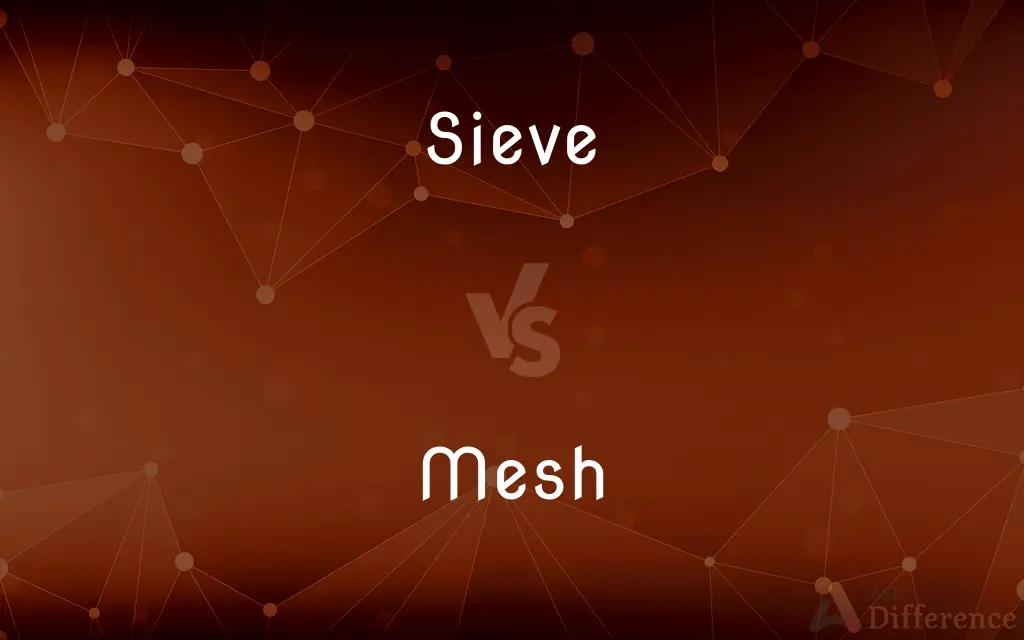Sieve vs. Mesh — What's the Difference?
By Urooj Arif & Maham Liaqat — Updated on February 26, 2024
A sieve is a tool with a meshed or perforated bottom used for separating coarse from fine parts of loose matter, while mesh refers to the material itself, made of interconnected strands, used in sieves and other applications.

Difference Between Sieve and Mesh
Table of Contents
ADVERTISEMENT
Key Differences
A sieve is a device used in various industries and cooking to separate particles of different sizes. Mesh, on the other hand, is the network of wire or thread that constitutes the filtering medium of the sieve. The mesh can also be used independently in applications like screens and filters beyond sieving.
The term "sieve" implies a specific use case, primarily focusing on the separation process, whether it's for sifting flour in baking or sorting aggregate in construction. Mesh, however, refers to the actual physical structure and can describe the fine netting used in sieves, as well as materials used in clothing, fencing, and more.
Sieves are characterized by their mesh size, which determines the fineness of particles they can filter. The mesh is defined by its weave or knit, the size of its openings, and the diameter of its threads or wires, indicating that while all sieves have a mesh, not all mesh is used in sieves.
The choice between a sieve and mesh depends on the application's requirements. For instance, a cook might use a sieve with a fine mesh to dust powdered sugar, while a gardener might use a mesh netting to protect plants from insects.
The effectiveness of a sieve is often directly related to the characteristics of the mesh it contains, including the material (metal, nylon, etc.), opening size, and overall durability. Conversely, mesh’s versatility extends beyond sieving to include uses in architecture, fashion, and industrial design, showcasing its broader application scope.
ADVERTISEMENT
Comparison Chart
Definition
A tool for separating particles based on size.
Interconnected strands forming a net-like barrier.
Primary Use
Separation and sifting in cooking, industry, etc.
Used in sieves, screens, filters, and various applications.
Composition
Typically consists of a frame holding a mesh.
Can be made of metal, plastic, fabric, etc.
Application Scope
Focused on sieving and filtering processes.
Broad, including sieving, fencing, clothing, and more.
Characterization
By the mesh size and material.
By weave or knit, opening size, and material.
Compare with Definitions
Sieve
Used in cooking, agriculture, and construction.
Workers sieved the gravel to remove large stones.
Mesh
Material made of interconnected strands.
The mesh bag held the beach toys.
Sieve
Characterized by the size of its mesh openings.
For finer flour, a sieve with a smaller mesh is used.
Mesh
Used in sieves, screens, and filters.
The window screen is made of a fine mesh to keep insects out.
Sieve
Essential in food preparation and industrial processes.
The chef passed the sauce through a sieve for smoothness.
Mesh
Applied in fashion, architecture, and more.
The architect incorporated a metal mesh in the building's facade.
Sieve
A tool used to separate fine particles from coarse ones.
She used a sieve to strain the flour.
Mesh
Can be woven, knitted, or welded.
The steel mesh was welded for added strength.
Sieve
Often made of metal or plastic with a mesh bottom.
The baker sifted powdered sugar through a fine sieve.
Mesh
Varies in size, from fine to coarse.
The filter uses a fine mesh to capture impurities.
Sieve
A sieve, fine mesh strainer, or sift, is a device for separating wanted elements from unwanted material or for characterizing the particle size distribution of a sample, using a screen such as a woven mesh or net or perforated sheet material. The word "sift" derives from "sieve".
Mesh
A mesh is a barrier made of connected strands of metal, fiber, or other flexible or ductile materials. A mesh is similar to a web or a net in that it has many attached or woven strands.
Sieve
To strain, sift or sort using a sieve.
Common Curiosities
What materials are used to make mesh?
Mesh can be made from metal, plastic, nylon, and other materials, depending on its intended use.
What determines a sieve's effectiveness?
The effectiveness of a sieve is determined by the mesh size and the material it's made from.
How do I choose the right sieve for a task?
Choose based on the size of particles you need to separate and the volume of material to be processed.
Can a mesh affect the flavor or texture of food?
In cooking, the mesh size can influence the texture of sifted ingredients, affecting the final dish's quality.
Are sieves only used in cooking?
No, sieves are used in various fields, including construction, agriculture, and science.
Can the mesh in a sieve be replaced?
In some sieves, the mesh can be replaced if it becomes damaged or if a different mesh size is needed.
Are all sieves round?
Sieves come in various shapes, including round and rectangular, to suit different applications.
Can mesh be used for security purposes?
Yes, metal mesh is often used in security screens and fencing to provide protection.
Can mesh be used for anything besides sieving?
Yes, mesh is versatile and used in many applications, including clothing, screens, and architectural elements.
How do I clean a sieve or mesh properly?
Cleaning methods vary, but generally, washing with soap and water and using a brush can remove trapped particles.
How is mesh size measured?
Mesh size can be measured by the number of openings per inch or the size of the openings in micrometers.
Is a finer mesh better for all sieving purposes?
Not necessarily; the choice of mesh size depends on the desired outcome of the sieving process.
What is the difference between mesh in fashion and in industrial use?
Fashion mesh is usually designed for aesthetics and flexibility, while industrial mesh focuses on durability and function.
Is there an environmental impact to using plastic meshes?
Yes, plastic meshes can contribute to environmental pollution if not disposed of properly or if they are not biodegradable.
How does the weave of a mesh affect its use?
The weave affects the mesh's strength, flexibility, and ability to filter specific particle sizes.
Share Your Discovery

Previous Comparison
Nonsensical vs. Nonsense
Next Comparison
Sleek vs. SlimAuthor Spotlight
Written by
Urooj ArifUrooj is a skilled content writer at Ask Difference, known for her exceptional ability to simplify complex topics into engaging and informative content. With a passion for research and a flair for clear, concise writing, she consistently delivers articles that resonate with our diverse audience.
Co-written by
Maham Liaqat













































